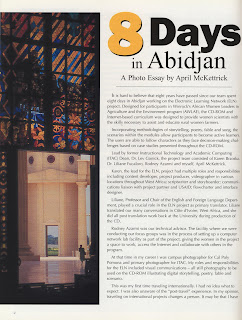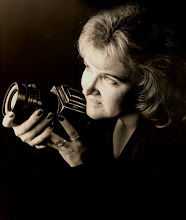Images of Peace: A photo essay
 In 2000, the Seeds of Peace CD-ROM won the silver CINDY award for educational interactive media. Nearly eight years later two members of that original team, Karen Brzoska and myself, April McKettrick, continue to create dynamic, multimedia projects as Instructional Designers in the division of Instructional and Information Technology (I&IT).
In 2000, the Seeds of Peace CD-ROM won the silver CINDY award for educational interactive media. Nearly eight years later two members of that original team, Karen Brzoska and myself, April McKettrick, continue to create dynamic, multimedia projects as Instructional Designers in the division of Instructional and Information Technology (I&IT).
The Seeds of Peace Project touched our hearts for many reasons but for me it is always the visuals that stay with me not only in my archives but etched in my memory as well. This project had a humanistic approach that, when combined with technology, reached the teens effectively. Working with those who have experienced generations of hatred, fear, and preconceived ideas of “the other side” was a challenge. Our approach to finding solutions was visual and interactive, breaking down barriers by showing kids how alike they were, not how different they thought they were.

Our experience began in 1999 with a trip to Maine where the camp for Seeds of Peace is located. Each year like the swallows to Capistrano, over four hundred and fifty teenagers from all over the world find their way to this remote location. Our team met up with the Seeds of Peace team to create the educational CD-ROM called “Peace in the Middle East: Empowering the Children of War to Break the Cycles of Violence.” The title alone was indicative of the challenge lying ahead of us in ‘Teaching Peace in the Middle East.’ Nevertheless, we were up for the creative challenge before us and jumped right in.

We met up with ten of the most amazing individuals that I will never forget. These children, wise beyond their years, had been raised in fear and witnessed atrocities that you can only hope your children will never have to experience. Yet here they were at this camp in hopes of finding peace, some with desires to become leaders, but all willing to create something completely unknown with strangers and all with the same goal of making a difference.
It is no surprise to me that eight years later I can still recall vivid memories of the Seeds of Peace kids and write about a project that touched my life in a way that most projects do not. As instructional designers we assess each project based on a series of criteria - but this one proved to have many obstacles. Not only did we have to gain the trust of our subject matter experts, we had to constantly keep in mind the delicacy of the content, respecting every word said with the sensitivity that was so deserved. We brought the ten teenagers to Cal Poly Pomona for the next phase of the project and engaged in sixteen dynamic days of content gathering, storyboard development and intensive multimedia workshops where Karen and Dave began to formulate the CD’s structure with the Seeds of Peace project leader.
Next, the entire team headed for the Middle East for three weeks of filming and photography. The team traveled to each of the teens’ homes where we had opportunities to meet with their families for interviews. This was an incredible time because not only did we get to experience the various cultures, but we were able to see the pride that these families had in their children and in their accomplishments.
360-degree Quick-Time Virtual Reality (QTVR) interactive movies proved to be some of my favorite elements of the finished CD-ROM because they gave the teenagers a chance to experience each other’s spaces. By using the mouse to navigate, the teens could move around each other’s bedrooms and check out elements like posters, photographs, school uniforms, and furniture. Clicking on embedded hot-spots would activate a video pop-up and the teen would talk via video about special things like a popular music group on a poster, or a school uniform being the “ugliest uniform in the whole wide world.” It was great because every kid thinks his or her uniform is the ugliest uniform in the whole wide world. Now the walls began to come down and kids started to see likenesses where before they could see only differences. The learning objects were achieving the outcomes we were hoping for as communication tools. We were beginning to break down the barriers because the kids saw their commonalities and they began to think of each other as fellow teenagers and fellow humans.
Headquartered in Jerusalem, we arranged to have the teens pair up and visit various historical locations that they chose to see and discuss, as well as take us on individual tours of some of their favorite spots. Some of these places included the Western Wall, the Masada, the Holocaust Museum, Gaza, Hebron and Petra, Jordan.
Many of the pictures in this photo essay have never been published and are some of the favorite images of my career. I hope you enjoy.
Peace doesn’t begin with deciding who is right or wrong, but with respecting one another’s views and understanding why someone else feels the way they do.
Once there is respect, there can begin to be peace.



















